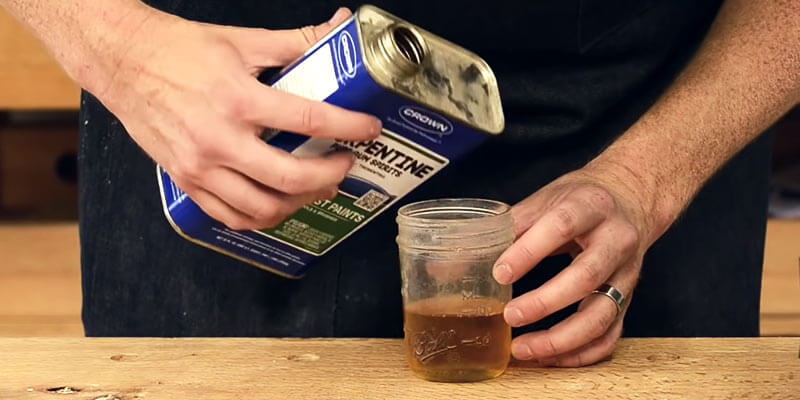Wood is an essential thing in everyone’s life. Woods are used everywhere in furniture interior design, office design, and many more. But can you use turpentine on wood? Well, it needs some treatment before and after usage. Many treatment products include wood filler, varnish, paint, turpentine, and many more. Turpentine is one of them.
Turpentine is a natural product used for almost every product and sector. However, it is common in woodwork. So every worker should know its usage. Also, turpentine is dangerous to wood. So it is essential to understand how to use it in the woods.
Definition of Turpentine
Turpentine is an oil made from resin. Turpentine is also called the spirit of turpentine, oil of turpentine, terebinthine, and so on. It comes from living trees, mainly pine trees. The texture of turpentine is semifluid. The color of turpentine is colorless or light yellow. It is a little bit odorous.
The usage of turpentine is uncountable. It is popular in thousands of sectors like food, manufacturing, health, and beauty. Plus, it’s seen in many kinds of paint and varnish solvents. Many food companies use it as a flavoring ingredient. Thus it is also used in man soap and cosmetics. It also works as a fragrance ingredient for perfusing and cleaning products. Many people use it on the skin for certain infections or joint pain.
Read: Can You Use An Angle Grinder As A Sander: Most Effective Ways
Instances Where You Could Use Turpentine
As we know, turpentine can be used in thousands of ways. It is suitable for a wide range of construction and engineering applications. So It can work great on woods. Moreover, it is highly durable in above-ground applications. Hence, the lifespan can be extended for decades.
To Remove Paint
Turpentine is commonly used to remove paint from any wood and other surfaces. Turpentine reacts to chemical things. It can remove paint in a little time. First, turpentine softens the paint layer. Then it can be removed by simply wiping. However, turpentine doesn’t affect the wood surface because of the painted layer. So it is important to use turpentine as little as it needs.
First, buy turpentine oil that is suitable for wood. Pour that oil on the painted areas. Then leave it for at least one hour. It will slowly separate the painted layer from the wood surface. After an hour, get a towel to wipe. Then rub slowly on the paint and wipe it.
Remove Varnish
Turpentine is also great for removing varnishing. Turpentine has a vast ability to remove any unwanted things from the wood surface. It works the same as removing paint. When raw turpentine is exposed at room temperature, it begins to thicken, absorbing oxygen from the air. In the varnish, it passes oxygen to its compound.
The process of removing varnish by turpentine is as easy as removing paint. First, put enough turpentine on varnished areas. Then, make sure to pour turpentine into a lower amount. Because too much turpentine can attach to natural wood, turpentine isn’t good for wood. Then wait until the varnish comes out. Then rub for some time and wipe away.
To Soften the Wood Paint
As we know, turpentine can be used for multiple purposes; it can also be used for painting. Turpentine is most commonly used in the art industry. In order to paint on wood or any other surface, the paint needs some treatment first. The paint has to be thin to spread. It also aids the paint in coating, bonding, and penetrating any kind of wood surface.
Turpentine works great as paint thinner. For example, paint thinners include turpentine, acetone, mineral spirit, and many more. Turpentine reduces paint viscosity. The paint has to be thin to spread easily. Turpentine allows the paint to dry faster. Also, cleaning brushes and other tools get easier if turpentine is mixed.
Related: Can You Use Mortar on Wood: An Ultimate Guide
Darker Side Of Using Turpentine On Wood
Thus turpentine is used for many kinds of woodwork; it can be dangerous to wood. As we know, wood is a natural and sensitive thing. It affects humidity or effective chemicals. At the same time, turpentine is also a natural oil. But it has some effective components which are not suitable for wood.
Raw turpentine can react to wood; it can hurt hue and luster. Wood can be burned immediately if raw turpentine is directly used. The caustic turpentine will affect the natural oil present in the woods. Wood is porous, so unmixed turpentine can go inside the wood and destroy every joint and part.
Can Turpentine Be Used For Cleaning Wood?
In simple words, NO. As we know, turpentine is harmful to the woods. So using turpentine for cleaning the wood isn’t a good idea. It will destroy the wood surface. However, processed turpentine can clean wood surfaces. But it will still have an impact or cause problems later.
Sandpaper can be a great option for cleaning wood surfaces. It perfectly removes dirt without harming the wood. First, buy sandpaper which is suitable for wood. Then carefully sand the dirty areas. After sanding, wipe or blow away all the sand. This is the safest way to clean wood surfaces than oil or turpentine.
Conclusion
So, can you use turpentine on wood? The Shower answer is “Yes.” Hence, the following roundup was all about using turpentine on wood. What is turpentine, definition, meaning, types, and many more?
There are several uses of turpentine. It works in many ways for woodwork. Know this usage.
Turpentine is harmful to wood. Know how and why it has a bad effect on wood. Cleaning by turpentine is also a bad option. Know how to clean wood without turpentine.
We have tried to give you as many solutions as we could. Know your problem and find the best option for your project.
